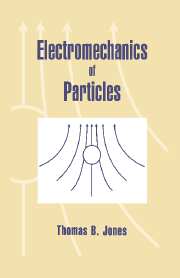Book contents
- Frontmatter
- Contents
- Preface
- Nomenclature
- 1 Introduction
- 2 Fundamentals
- 3 Dielectrophoresis and magnetophoresis
- 4 Particle rotation
- 5 Orientation of nonspherical particles
- 6 Theory of particle chains
- 7 Force interactions between particles
- Appendix A Analogies between electrostatic, conduction, and magnetostatic problems
- Appendix B Review of linear multipoles
- Appendix C Models for layered spherical particles
- Appendix D Transient response of ohmic dielectric sphere to a suddenly applied DC electric field
- Appendix E Relationship of DEP and ROT spectra
- Appendix F General multipolar theory
- Appendix G Induced effective moment of dielectric ellipsoid
- References
- Index
5 - Orientation of nonspherical particles
Published online by Cambridge University Press: 02 December 2009
- Frontmatter
- Contents
- Preface
- Nomenclature
- 1 Introduction
- 2 Fundamentals
- 3 Dielectrophoresis and magnetophoresis
- 4 Particle rotation
- 5 Orientation of nonspherical particles
- 6 Theory of particle chains
- 7 Force interactions between particles
- Appendix A Analogies between electrostatic, conduction, and magnetostatic problems
- Appendix B Review of linear multipoles
- Appendix C Models for layered spherical particles
- Appendix D Transient response of ohmic dielectric sphere to a suddenly applied DC electric field
- Appendix E Relationship of DEP and ROT spectra
- Appendix F General multipolar theory
- Appendix G Induced effective moment of dielectric ellipsoid
- References
- Index
Summary
Introduction
Elongated magnetizable particles respond to a magnetic field by aligning with their longest axes parallel to the field vector. This phenomenon is exploited in the familiar physics demonstration where iron filings are sprinkled on a sheet of paper placed atop a permanent magnet. As they land on the paper, the particles align themselves parallel to the field of the magnet and, if care is taken to distribute the particles uniformly, their pattern reveals the form of the magnetic field. Very similar behavior is manifested by elongated dielectric or electrically conductive particles in an electric field.
The physical origin of the orientational torque exerted on a particle is closely related to that of rotational torque discussed in Chapter 4 and, in fact, a particle may exhibit a combination of rotational dynamics and orientational behavior under certain conditions. There are, however, some important distinctions to be drawn between the two effects.
An orientational torque acts only upon a particle exhibiting some type of anisotropy due to either intrinsic properties such as crystalline anisotropy or extrinsic factors such as shape. Rotational torque, on the other hand, can be experienced by a spherical isotropic particle.
In a rotating field, the orientational torque can produce steady motion, but only at synchronous speed. In contrast, rotational torque induces steady rotation at sub-synchronous speed.
Orientational torque does not depend on either dielectric or ohmic loss, while rotational torque requires it.
Particles can experience orientational torque in both AC and DC electric fields. With the exception of the Quincke effect (c.f., Section 4.4), steady rotation is ordinarily observed only with an AC field.
- Type
- Chapter
- Information
- Electromechanics of Particles , pp. 110 - 138Publisher: Cambridge University PressPrint publication year: 1995
- 1
- Cited by



